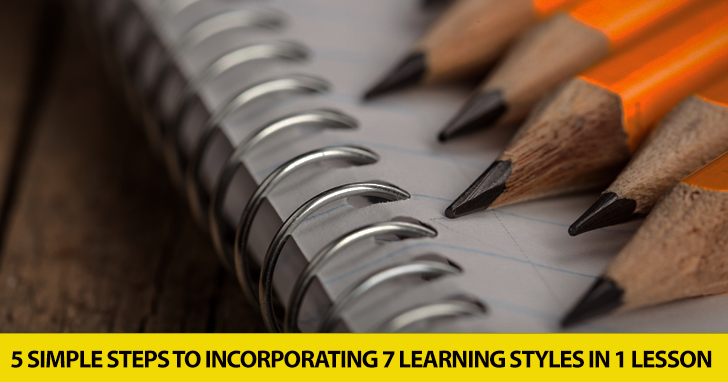Seven in One Blow: 5 Simple Steps to Incorporating 7 Learning Styles in One Lesson


At the bottom are all the students who kind of get it, who remember some information from class. At the top of the pyramid are those few students who seem to retain almost everything that they learn in class. And at the bottom and at the top, along with their students, are the teachers who have these students in class. Some are less effective and some more effective, as their students’ performance shows. Every teacher falls on the pyramid somewhere, even you. But before you settle in and get comfortable at any of the lower levels, see how easy it is to get to the top and be a teacher whose students achieve amazing results in their English classes.

Students retain twenty percent of what they hear. It’s not very impressive. And for English as a second language learners, the percentage is even lower. The language barrier factors in at nearly every level, and a student’s listening comprehension skills and knowledge of vocabulary will, generally, negatively affect how much of what he hears he is able to retain.
The good news is it’s simple to move students up from this meager twenty percent retention. Getting students involved in the learning process, things you probably do every day in your ESL class, will increase how much they retain.
One way to improve students’ listening comprehension is to give them as many different opportunities to practice as possible. This includes bringing multimedia into your classroom – tape recordings and podcasts for example. Show them videos of people giving speeches, and bring guest speakers into your classroom. Even inviting another teacher to come and talk to your students will help them improve their listening comprehension since different people speak with different vocabulary, grammar, and pronunciation. The good news is that all these things work to improve listening comprehension. The bad news is that even students with the best listening comprehension will only retain around twenty percent of what they hear. But we’re not to the top of the pyramid yet.
Take a step up. “Oh, I’ll just read it in the book.” Books may contain a great amount of information whether you are studying English or entomology, but that doesn’t mean they are the best source for learning. According to research in education, students generally remember about thirty percent of what they see. This includes reading books, looking at graphics, and any other process that involves only the eyes and the brain. A lot of ESL students prefer reading information to attending class. Perhaps it is because they can take their time and look up words that are unfamiliar to them. They think that working at their own pace, even if it’s only through visual means, will help them learn English better. Even with this extra attention to learning, however, most of them will not retain all the information on the page, only about thirty percent.
It’s important for teachers to remember this. Sometimes the best option for your class seems to be independent work, something reading based. And those kinds of activities are not bad. But it does matter how and when you use them. These independent reading based activities are best as review of information rather than a means of presenting new information. When students read information they already know, it will increase retention. When they read new material as their only means of learning it, their retention is less than ideal.
Very few ESL teachers either present a lesson orally or have students read about it in a text or from a worksheet. Most teachers, no matter what the subject, have figured out that doing both – presenting information orally and visually – gives their students more success when it comes to retaining information. Research supports this conclusion, and they move up to the next level of the pyramid. If student see and hear the same information, they will retain approximately fifty percent of that information. That’s why we teachers write on the board while we are teaching students. It gives a double punch of input. That double input almost doubles how much students remember of what they have read and heard. Here on the level of hearing and seeing, most students become comfortable, and teachers can, too. But it’s so easy to keep going up, why stop there.
Yes, remembering fifty percent of what we present in class is probably a pretty good result, but with just a little change, we can help our students become even more successful. Just taking one other small step in a lesson will increase student comprehension to a stunning seventy percent. Let your students talk. That’s the big factor – speaking. Traditional classroom teachers may balk at the idea, but as ESL teachers, part of our job is to get students speaking English. As a result, talking in class is always a good thing. Well, most of the time it is. And research shows that students generally retain about seventy percent of what they hear, see, and say in class. That means all those small group discussions are great not only for pronunciation work, but also for helping students remember information in grammar class, vocabulary class, and writing class. I’m not espousing chanting verb conjugations as a way to improve student comprehension, but think about adding simple activities such as these to your class: give students a jigsaw in reading class so each person must orally communicate his information to his group. Have students interview each other while using a new grammar construction. Play a game of cards to teach vocabulary (memory, go fish, etc.) and have students read the matches they make before setting their cards aside. Let students read instructions and answers aloud when they are completing a worksheet, even if it’s only with one or two other students. These simple things will make a difference in how much your students learn and how well they learn it.
Who would complain if their students remembered seventy percent of what they taught in class? But you don’t have to stop there. Your students can achieve approximately ninety percent retention with just one more step in the teaching/learning process: doing. Doing can mean a lot of different things, and there are probably as many interpretations of that word as there are teachers in the world. I like to think of doing in terms of kinesthetic learners – students who need to get their hands involved when they are learning. Though they may do okay with listening, reading, and even speaking, if they can handle and move objects, build things, draw things, have objects in their control that relate to the lesson, they soar. Because only a small number of students in your class are probably kinesthetic learners, it might seem like you are misusing your all too short class time to include hands on activities in every lesson, but you aren’t. Even aural and visual learners will benefit from kinesthetic activities in class. For specific ideas for doing activities in the ESL classroom, look here.
When you boil it all down, only our students can ensure their own success in learning English. But by including aural, visual, speaking, and doing activities into our lesson plans, we can make a difference in how well and how easily our students learn. And when we do, we can be assured we have given them the best chance they have to succeed.
Please share your successes in the comments section below.